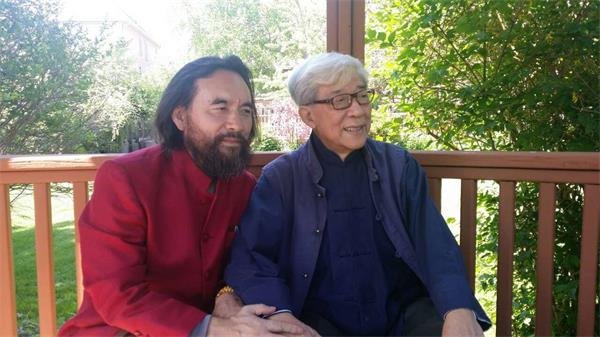
Remembering
Master Tam Shek-wing: A Message of Wisdom
Editor’s
Note: Master Tam Shek-wing, founder of the Sino-Tibetan Buddhist Studies
Association in North America (STBSA), is a renowned Buddhist scholar and
Dzogchen master. His insightful writings, moral integrity, and unparalleled
contributions to the spread of Buddhism make him a truly remarkable figure of
our times. His encounter with Master Xue Mo in North America ignited the shared
passion and deep camaraderie between these two distinguished spiritual leaders.
Below is the English translation of a reflective essay by Master Tam,
originally published in May 2015. The original Chinese text is included for
reference.

Joyfully
Meeting Master Xue Mo
By Master Tam Shek-wing (Dorje Jigdral,
1935–2024)
Acclaimed
author Xue Mo began his North American journey with a visit to meet me in
Toronto.
Xue
Mo is widely known for his novels, which have garnered great popularity and a
devoted readership. However, his true accomplishments lie in his mastery of
Tibetan Buddhism. As a lineage holder of the Shangpa Kagyu tradition, he is
perhaps the sole Shangpa Kagyu master actively teaching in mainland China
today.
The
Kagyu lineage is divided into two branches: the Dagpo Kagyu, which encompasses
many sub-lineages such as the Karma Kagyu, led by the Karmapa, and the Shangpa
Kagyu, a single, unbroken lineage that flourished during the Yuan and Ming
dynasties. During the Hongwu era, the great Nyingma master Thang Tong Gyalpo
took refuge under Lama Khedrub Dorje Shönu, a Shangpa Kagyu master, and studied
the Shangpa teachings. As a result, the Nyingma tradition integrated elements
of the Shangpa teachings, including the “Five Tantric Deity Sadhana” and the
“Six Yogas of Niguma.” One of Thang Tong Gyalpo’s disciples transmitted these
teachings to Riwoche, where the Shangpa influence remains evident in the
meditation practices of the local Nyingma community.
After
spending 20 years in retreat, Xue Mo moved from Liangzhou to Zhangmutou in
Dongguan, where he has continued his practice and writing in solitude. During
this time, he read some of my works, which inspired his desire to meet me.
Through the kind introduction of Professor Shen Weirong, our meeting was
arranged. Given the historical ties between the Nyingma and Shangpa Kagyu
lineages, I was delighted to welcome him. Upon meeting Xue Mo, I immediately
recognized the disciplined demeanor of a dedicated yogi—a clear reflection of
his spiritual accomplishment. His presence reminded me of my own lapses in
recent years, as I have devoted less time to formal meditation.
Accompanying
Xue Mo was one of his disciples, Huang Wentao, who shared details of his
teacher’s simple lifestyle. Xue Mo lives alone on the seventh floor of an old
building in Zhangmutou, only returning to his wife and son’s home for lunch
before resuming his solitary practice. Sometimes, his dinner consists only of
fruit or a handful of rice crackers. For this trip to North America, he even
brought along a bag of rice crackers, exemplifying his ascetic way of living.
It is not due to financial constraints—he is a respected author, a member of
the Chinese Writers’ Association, and Vice Chairman of the Gansu Writers’
Association. Rather, his minimalist lifestyle reflects the spirit of the
Shangpa Kagyu tradition, which emphasizes austerity. This is likely rooted in
the lineage’s cultural base in Gansu, a region that contrasts sharply with the
material affluence of cities like Beijing, Shanghai, or Guangzhou.
For
dinner that evening, I reserved a table at the Best Fortune Restaurant, one of
the few in Toronto that still serves authentic soups made with fish bones or
oxtail stock. Since Xue Mo comes from Liangzhou, I ordered fresh Alaskan crab
and geoduck to offer him a taste of coastal cuisine. Initially worried that he
might abstain from seafood, I was relieved when he graciously accepted.
Otherwise, I had planned to order Mongolian roasted lamb instead.
Our
conversation was both lively and enriching. When discussing meditative
practices, just a few brief exchanges were enough to establish mutual
understanding. Our shared meditation foundation lies in the Tathagatagarbha, or
“Buddha-Within,” focusing on the clear light, and both of us have actualized
Buddha-nature. With this shared basis, even a glance or handshake conveyed an
immediate heart-to-heart connection.
Xue
Mo stayed for only half a day before continuing his North American tour. I
expressed my hope that he would establish a center here to spread the Dharma
and encouraged him to translate his major tantric works, such as the Luminous
Mahamudra series, into English. With a growing number of Western disciples
under my guidance, I see few books that adequately address their needs. The
Luminous Mahamudra series would be a valuable resource for them, and I am
confident that its English translation would attract many sincere
practitioners. Xue Mo wholeheartedly agreed, and we discussed potential
collaborations with a publisher I know well.
The
Shangpa teachings, which have been shrouded in secrecy for centuries, deserve
to be revealed to the world. As prophesied by Guru Rinpoche, certain teachings
once deemed esoteric should now be made accessible. Xue Mo shares this view,
recognizing the responsibility of our generation to bring these hidden
treasures to light.
Meeting
such a genuine and accomplished master as Xue Mo in my later years indicates a
profound karmic bond with him. Still relatively young, he has a long road ahead
in transmitting the Dharma. I wish him every success in guiding spiritual
seekers worldwide on the path to enlightenment.